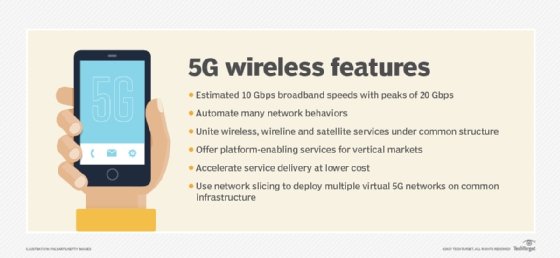
jeffreyjcoleman - stock.adobe.co
Getting started with 5G network planning
This feature explores the basics of 5G technology, concerns from industry insiders, where it currently stands and predictions for its future.
The new year will ring in new developments for the networking industry. Among them, there will be more trials -- or tribulations -- of fifth-generation wireless technology, more commonly known as 5G.
Further deployment of 5G services is expected in metropolitan areas going into 2019, as organizations prepare for full deployment in a few years. But before this adoption happens, organizations should know where 5G stands now and how to begin planning for its future.
This compilation of expert insights advises organizations where to start their 5G network planning. The insights range from the basics of 5G to predictions for the wireless technology's future.
How can network pros prepare for 5G mobile technology?
Network professionals may not have all the information they need for this industry shift to 5G, according to network engineer Lee Badman. He shared his thoughts on the possible effects 5G technology could have on industry professionals and their operations.
Badman said the naming of 5G for wireless LANs (WLANs) is confusing, as it follows the same naming system as mobile technology. Additionally, he said 5G is loosely defined, and the industry is years away from a set standard. He said he anticipates years of evolution after 5G's initial full deployment.
Other areas of concern are pricing, integration with current technology, and 5G's effect on rural areas and WLANs, according to Badman.
Explore more of Badman's thoughts on 5G network planning.

Understand the basics of 5G wireless networks
The first step in 5G network planing is learning what 5G networks offer. This SearchNetworking feature detailed the services offered by 5G, the benefits it provides and the service providers helping to drive 5G development.
At its core, 5G promises to change enterprises' use of advanced technologies through high-speed data delivery. The wireless technology looks to carry more data at faster speeds to increase performance, create potential for new technologies, and improve productivity and business efficiency.
The two main services 5G offers are fixed wireless broadband and mobile services. While these were deployed in metropolitan areas throughout 2018 and will continue to be in 2019, they will become widely available in 2020. However, full deployment is not expected until 2025.
Learn more about the building blocks of 5G.
5G wireless technology trials and other promises
Throughout this year, 5G technology was in its beginning stages of development. Service providers, such as Verizon and AT&T, trialed 5G networks in several metropolitan areas. This SearchNetworking feature explored who will benefit from 5G and the services unique to this technology.
Industries that need low latency and high throughput -- such as healthcare, financial services, energy and other field-service organizations -- should expect significant effects from 5G. Businesses with specialized communications requirements, such as IoT applications, could see 5G benefits first.
Additionally, 5G will introduce network slicing. Specific to 5G, this service divides a single network into separate virtual slices for enterprise customers. Each slice serves a different business service, which could benefit healthcare services in particular.
Discover more about the trials of 5G technology.
Plan for the future of 5G in the enterprise
Organizations can anticipate what the eventual 5G rollout will look like, because it could mirror the 4G rollout, according to Matt Schulz, senior mobile channel manager at USAA, a financial services company based in San Antonio. In this tech tip, Schulz discussed his vision for the future of 5G and what it means for organizations adopting the technology.
Schulz drew parallels between the deployment of 4G and what he anticipates for 5G. He specifically noted the price of 5G. While the cost may initially be greater than people expect, it will decrease over time -- as it did with 4G. He also speculated that the promised speed and intensity of 5G technology could cause more issues than benefits in its infancy.
However, Schulz predicted 5G services would benefit remote workers and could propel edge computing by creating a shift from cloud strategies to edge strategies.
See all of Schulz's predictions for the future of 5G.






